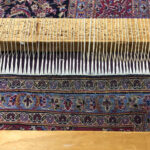The realm of rug repair, steeped in tradition and finesse, is a captivating blend of artistry and precision. It’s not just about mending a piece of fabric; it’s about restoring a piece of history, a narrative, a work of art. Through the right tools and techniques, worn-out rugs are not only revitalized but also have their stories seamlessly continued. Let’s embark on a journey through this meticulous craft.
The Essential Tools
- Curved Needles: Ideal for sewing edges and tight spots, the curvature allows for a more controlled stitch, especially on thick or plush rugs.
- Straight Needles: Used for general repairs, their varied sizes cater to different rug thicknesses and repair needs.
- Scissors: Precision is crucial in rug repair. Sharp, high-quality scissors ensure clean cuts, preventing further damage to the rug’s fibers.
- Hooking Tools: Employed in latch hooking techniques, these tools pull yarn through the rug’s backing, essential for tufted rug repairs.
- Tweezers: Handy for untangling knotted threads or placing fibers with precision.
- Matching Yarn: The right color and texture of yarn are essential for seamless repairs, ensuring that the mended area blends perfectly with the rest of the rug.
- Foundation Material: Depending on the type of repair, new foundation material might be required, especially in cases of severe damage or wear.
Renowned Techniques
- Re-weaving: This technique involves re-creating the rug’s weave where it’s been damaged. It requires a lot of skill and patience, as the new weave needs to blend seamlessly with the original pattern and texture.
- Patchwork: In cases where a specific section of a rug is too damaged for re-weaving, a patch can be crafted and sewn into place. The challenge lies in finding or creating a patch that matches the original rug in terms of color, pattern, and texture.
- Fringe Repair and Replacement: The fringe is often the first part of a rug to show wear. Repair might involve re-knotting the fringe or, in some cases, completely replacing it.
- Overcasting: This technique is used to prevent the edges of a rug from unraveling. It involves wrapping the edge with yarn to protect and strengthen it.
- Resizing: Sometimes, damage is so extensive that the best solution is to resize the rug, removing the damaged areas and re-edging the rug to ensure it remains symmetrical and aesthetically pleasing.
FAQ
Most rugs can be repaired, but the extent of damage and the cost of repair play a role in the decision. Consulting with a professional rug repair expert can provide clarity.
While minor repairs can be tackled at home, significant damage or valuable rugs are best entrusted to professionals to maintain their value and aesthetics.
The duration varies based on the damage’s extent and the repair technique used. While minor fixes might take a few hours, extensive repairs can stretch over days.
Regular maintenance, gentle cleaning, rotating the rug to ensure even wear, and using rug pads can significantly reduce wear and tear.
In the hands of a skilled artisan, the craft of rug repair transcends mere functionality. It’s a testament to the enduring allure of rugs, their stories, and the dedication to preserving them for generations to come. Through the right tools and techniques, every thread mended is a chapter continued, ensuring that the tapestry of tales woven into rugs lives on.


